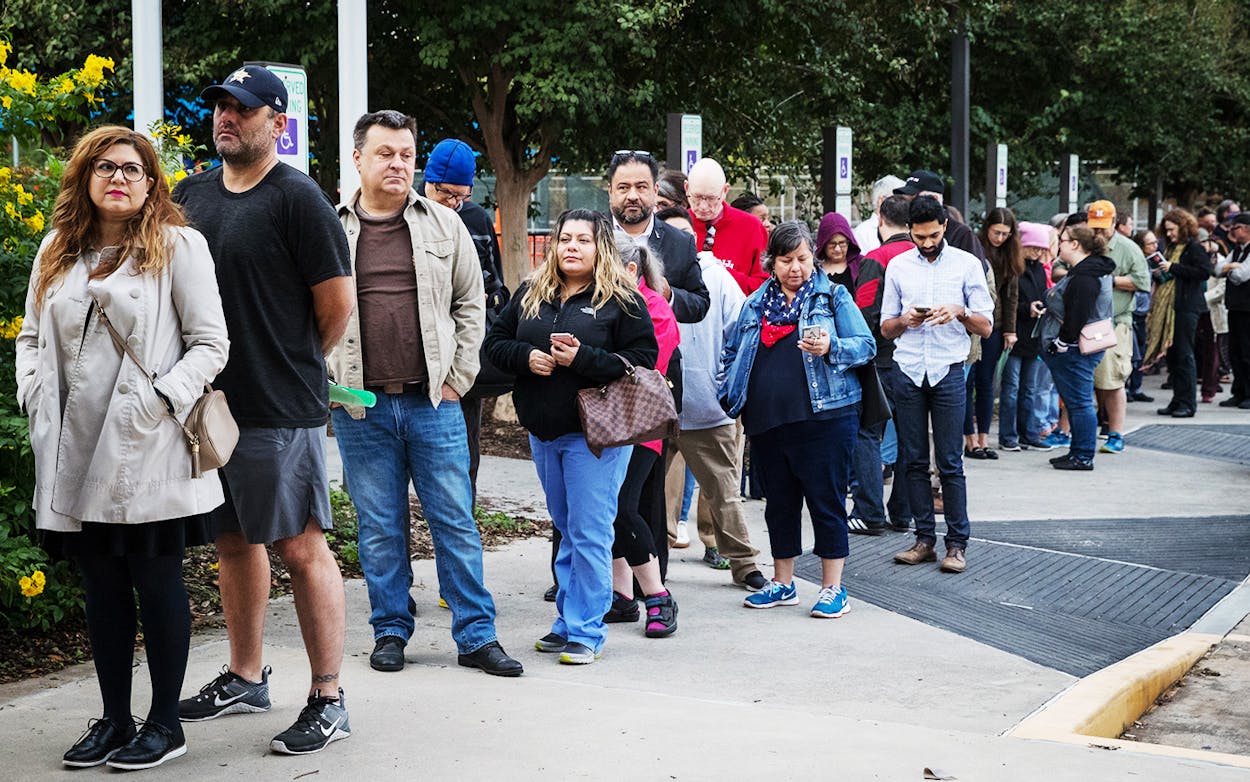In the August issue of Texas Monthly, I told you the U.S. Senate race in Texas was going to be a proxy war over President Trump, with incumbent Republican Ted Cruz and Democratic challenger Beto O’Rourke in the role of surrogates. That is exactly how this race has played out, with early vote turnout coming close to 2016 presidential year levels, surpassing that vote in at least five populous Texas counties. A total of 8.9 million Texans cast ballots in 2016, with Donald Trump carrying the state over Democrat Hillary Clinton by a margin of 52 percent to 43 percent. Through early voting this year, already 4.8 million people had cast ballots in the state’s top 30 counties. Target Smart, a Democratic consulting website, is reporting that the statewide early vote was 5.8 million ballots. In 2016, there were more than 2.2 million ballots cast on Election Day, so a lot can still happen before the polls close in El Paso—O’Rourke’s hometown—at 8 p.m. Central Standard Time.
The contest between Cruz and O’Rourke has overshadowed every other state race. Cruz has consistently led in surveys of Texas voters, but O’Rourke has rallied his supporters to the idea that he can win if they turn out to vote. President Trump visited Texas to tell Republicans to vote for Cruz as an important ally for him in Congress.
What to watch for as the votes come in tonight.
The Texas Secretary of State will be reporting unofficial returns on its website. Rural counties and those with smaller populations will come in first. So expect Cruz to take an early lead. O’Rourke’s strength will be along the Rio Grande and in the big cities. The urban votes usually come in last.
Because this is a turnout election, in the early stages watch the spread rather than the vote count. A big vote spread favors Cruz, while a narrow spread is to O’Rourke’s advantage.
President Trump carried Collin County by 56 percent of the vote; Denton by 57 percent; Lubbock by 66 percent; Montgomery by 73 percent. If Cruz’s percentage is less in those counties, that improves O’Rourke’s chances statewide. Democratic presidential nominee Hillary Clinton carried Bexar County by 54 percent of the vote; Dallas by 61 percent; Harris by 54 percent; and Travis by 66 percent. If O’Rourke’s percentages stay the same or go down in those counties, it is good news for Cruz, because it means O’Rourke is not cancelling out the Republican rural advantage.
Also watch the returns for Libertarian Senate candidate Neal Dikeman. Libertarian presidential candidate Gary Johnson received three percent of the statewide vote in 2016 and was as high as almost five percent in some Republican-leaning congressional districts. Even if O’Rourke loses, Dikeman could reduce Cruz’s margin of victory and give Democrats a psychological boost by claiming a close contest. Historically, Democrats have lost Texas by about nine percentage points or more. A blowout for Cruz would dishearten Democrats. A close result with an O’Rourke loss would give Democrats the ability to argue they made gains that can be built upon. An O’Rourke victory would represent a seismic shift similar to Republican John Tower’s 1961 special election victory that became the cornerstone of building the modern Republican Party in Texas.
Bellwether counties:
Tarrant County is the last major urban county that still votes Republican. If it goes for O’Rourke, that could represent a permanent shift in the Texas political landscape. However, even if Cruz wins the county, watch the state Senate District 10 race where Democrat Beverly Powell is challenging Republican incumbent Konni Burton.
There are five of the most populous Texas counties that had an early vote turnout that exceeded 2016 presidential election levels. Travis and Webb are Democratic counties. Three counties went for Trump: Denton, Williamson, and Hays. Trump won Denton and Williamson by substantial margins, but he carried Hays by a mere 602 votes.
The congressional trio.
There are three congressional districts that are held by Republicans but were carried by Clinton in 2016. The national Democratic Party has put money and effort behind carrying all three of those districts. Two of them are in Dallas and Houston, counties that have been trending Democratic this decade.
In Houston, 7th District incumbent Republican John Culberson faces Democratic attorney Lizzie Fletcher. In Dallas, 32nd District Republican Pete Sessions is being challenged by former NFL player Collin Allred. In the 23rd District stretching from San Antonio to El Paso, incumbent Will Hurd is facing a challenge from Democrat Gina Ortiz Jones.
The Texas House speaker’s race
This one is not on the ballot. Members of the Texas House elect their own leadership. But state House elections, particularly in Dallas and Tarrant counties, will affect how moderate the next speaker will be. Retiring Speaker Joe Straus was far more focused on business issues than social conservative culture war issues. Without going through a laundry list of candidates, the races for state representative to watch are Republican House districts 93 in Fort worth; 94 in Arlington; 96 in Crowley; 102 in Dallas; 105 in Grand Prairie; 108 in Highland Park; 113 in Seagoville; 114 near White Rock Lake; and 115 Addison. The Dallas Democratic District 107 is held by Victoria Neave, who narrowly won the seat in 2016. In Houston, the most centrist Republican in the House—District 134 incumbent Sarah Davis—faces the possibility that a big Democratic turnout would help Allison Sawyer spoil Davis’s re-election.
- More About:
- Politics & Policy
- Ted Cruz
- Beto O'Rourke






